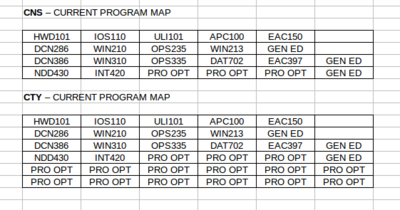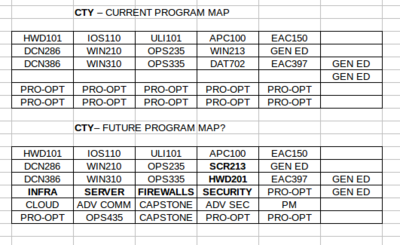Difference between revisions of "OPS"
| Line 39: | Line 39: | ||
|- | |- | ||
| − | |[[Image:current_cns_cty.png|thumb|400px|Current Curriculum Map of CNS/CTY diploma Programs | + | |[[Image:current_cns_cty.png|thumb|400px|Current Curriculum Map of '''CNS''' / '''CTY''' diploma Programs: '''Winter 2015''']] |
|[[Image:cty.png|thumb|400px| ]] | |[[Image:cty.png|thumb|400px| ]] | ||
Revision as of 16:18, 23 January 2015
OPS STREAM
OPS Stream Discussion
Overview
This WIKI is a collection of curriculum discussions held in May 1024 and January 6, 2015, as well as discussion from PAC committee meetings have been held several times during 2014. The term PAC stands for Program Advisory Committee. This committee consists of management, faculty, industry professionals, and former CNS/CTY students that meet to review and discuss the current curriculum and recommend or advise any changes that may need to be made. It is the intension of this WIKI to provide a collection point for ideas and collaboration between courses for the OPS Stream to assist in future curriculum development as a result of these PAC meetings.
Curriculum Discussion for each course in OPS Stream:
- [ ULI101 - Curriculum Discussion ]
- [ OPS235 - Curriculum Discussion ]
- [ OPS335 - Curriculum Discussion ]
- [ OPS435 - Curriculum Discussion ]
- [ OPS535 - Curriculum Discussion ]
Recommendations From Recent PAC Meetings (based on discussion notes CNS/CTY Curriculum: Discussion Transcript ):
- The curriculum discussions for the CNS/CTY programs have drawn attention to several key areas:
(Note current and proposed CNS/CTY curriculum maps display below)
- Create an identical skill base for both CNS and CTY programs for the first four semesters
- Students in the CTY program (after completing co-op) sometimes want to graduate with CNS and fail to see the point of taking an additional 2 semesters. The problem is that when students are enrolled in the CTY program, the CTY program requires them to complete the 6 semesters. A number of students will accept employment without having completed the CTY diploma certificate (this affects the perception of student success and retention). Creating an identical skill base for both CNS and CTY programs will offer employers with a minimum level of employee competence and provide a conduit for students to pursue the CTY diploma certificate if desired.
- Increase retention of CTY students by offering real IT industry projects within the fifth and sixth semesters
- With identical core requirements for the first four semesters of the CNS/CTY programs, the fifth and sixth semester of the CTY program can roll-out courses to allow students to develop a better understanding of the industry by working with an IT company or organization on a related task (referred to as a "capstone project"). By allowing students to with an industry partner for at least two semesters, the student is encouraged to complete the CTY program.
- Promote student success by channeling them to a one year, lower credential diploma (with the option of re-applying to CNS/CTY upon successful completion)
- There has been discussion in curriculum meetings to channel cns/cty students that are unsuccessful in their first semester to transfer to obtain a one Year (reduced credit) Diploma certificate. This course would provide the minimum (essential) skills for students to work in basic job categories in the IT industry. Students that successfully complete this program may be allow to re-apply to the CNS/CTY program.
- Align hardware concepts to reflect data servers (eg. data centers) as well as desktop (client-server) models
- Subject matter experts in the CDOT applied research division have indicated gaps from what students learn and what is currently adopted in the IT industry. One example would be students, although having skills to create Ethernet cables for workstations, lack the subtle skill to wire a server rack. In an effort to eliminate this discrepancy, newer course will be introduced to deal with these issues including infrastructure, advanced data communications, advanced firewalls, and security. One suggestion is to split the NDD430 course into two separate courses, the first emphasizing infrastructure and the second emphasizing configuring a server and running services. The hardware course will be separated into two separate courses, the first focusing on the desktop, and the second to focus on data centers. In addition, a course in project management is recommended to be added as a government curriculum requirement. During the curriculum development process, courses in CNS and CTY should be reviewed and improvements made to maintain consistency and assist in student success.
The Challenge:
- Curriculum development can seem like a daunting task! On one hand, it is important for curriculum to grow and develop in order to take advantage of changing trends and help to better train our students for industry. On the other hand, great care must be taken to not make changes in course curriculum without considering the impact on other courses, and to make certain that content and learning skills are maintained in the learning outcomes for courses until a major curriculum review and possible curriculum revisions are warranted. Other challenges include limited time frames for all faculty to meet at the same time to discuss curriculum issues.
This WIKI's Approach:
- This WIKI hopes to encourage on-line repository of OPS stream course discussions to provide to help view all courses and to foster communication between faculty members. Faculty members can simply view and contribute freely to the the curriculum discussion. To help keep the discussion on track, a Triage framework has will be used to prioritize suggested improvements into short-term, long-term, and wish-list categories. In this way, faculty can sort out easy to perform changes or "tweaks" to courses and foster discussion among courses in the OPS stream. It is hoped that this method allows for transparency, and allows for an encouraging and welcoming area for faculty to make suggestions / improvements to course curriculum.
- Faculty members (new hires and existing) can be directed to this site when teaching these courses for the first time to help gain the fundamental importance of the course curriculum, to note the importance of flow between the streaming courses, and to perhaps integrate this knowledge into their course delivery to provide students with forward linkages (i.e. a "heads-up") of why the current course content topics are essential to their success in the CNS/CTY programs.
General Definitions (Purpose) of OPS Streams:
There are two basic diploma programs at Seneca College that utilize the OPS stream:
- CNS (Computer Networking and Technical Support)
- This program places emphasis on practical subjects and "hands-on" training delivered in specialty labs. These dedicated labs are configured for various environments such as Linux, Microsoft Windows, networking, OC hardware, Internet, AS/400, and RS/6000. Through these labs, students have access to stand-alone, clustered and networked PC's along with a host of LAN servers and mid-range computers.
- CTY (Computer System Technology Overview)
- Similar in certain respects to CNS program, but contains 2 additional semesters to allow students to specialize in areas such as: Security, Data Communications, and Network Administration.
- [ OPS Stream Meeting (November 13, 2013) ]
- Meeting Minutes for CNS/CTY PAC Committee Meetings

